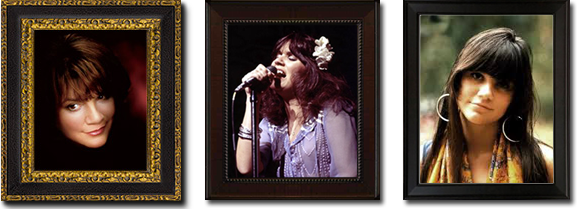

Interpreter of Songs

Born July 15, 1946 Tucson, Arizona
Linda Ronstadt is considered an “Interpreter of her times”. Her natural vocal range spans several octaves from Contralto to Soprano. She has covered everything from Folk to Cajun music and almost everything in between.
 Early Life
Early Life
Linda Ronstadt’s early family life was filled with music and tradition, which influenced the stylistic and musical choices she later made in her career. Growing up, she listened to all types of music. She credits her mother for her appreciation of Gilbert and Sullivan and her father for introducing her to the traditional pop and Great American Songbook repertoire that she would, in turn, help reintroduce to an entire generation. Early on, her singing style had been influenced by singers such as Lola Beltran and Edith Piaf; she has called their singing and rhythms “more like Greek music…It’s sort of like 6/8 time signature…very hard driving and very intense” She also drew influence from country singer Hank Williams. She admires Callas for her musicianship and her attempts to push 20th-century singing, particularly opera, back into the Bel Canto “natural style of singing”. A self-described product of American radio of the 1950s and ’60s, she was a fan of its eclectic and diverse music programming.
At 14, Ronstadt formed a folk trio with her brother Peter and sister Suzy. They billed themselves as “The New Union Ramblers”, “The Union City Ramblers”, and “The Three Ronstadt’s”, and the trio played coffeehouses, fraternity houses, and other small venues.
The Stone Poneys
In 1964, Linda Ronstadt moved to Los Angeles to form a band with Bob Kimmel, who had already begun co-writing several folk-rock songs with guitarist-songwriter Kenny Edwards. As The Stone Poneys, the band was signed by Nik Venet to Capitol and released three albums in a 15-month period in 1967-68: The Stone Poneys; Evergreen, Volume 2; and Linda Ronstadt, Stone Poneys and Friends, Vol. III. The band is best known for their hit single “Different Drum” (written by Michael Nesmith prior to his joining the Monkees), which reached No. 13 on the Billboard Hot 100. The song remains one of Linda Ronstadt’s most popular recordings. While Stone Poneys broke up before the release of their third album, Kenny Edwards recorded and toured with Ronstadt from the mid-1970s to the mid-1980s.
Solo Artist
Ronstadt released her first solo album, Hand Sown…Home Grown, in 1969. It is considered the first alternative country record by a female recording artist. Ronstadt’s second solo album, Silk Purse, was released in March 1970. Her studio album recorded entirely in Nashville, it was produced by Elliot Mazer, whom Ronstadt picked on the advice of Janis Joplin, who had worked with him on her Cheap Thrills album
In 1973 On the Don’t Cry Now album, most tracks were produced by J.D. Souther and Boylan. She asked Peter Asher to help her produce two tracks, “Sail Away” and “I Believe in You”. Asher was musically more on the same page with her than any producer she had worked with before, and he worked with her collaboratively. Asher went on to produce and manage most of her subsequent albums.
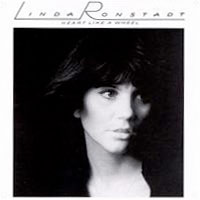
Heart Like a Wheel
Linda Ronstadt, ca. 1974, on the cover of the Grammy winning album and 2x platinum certified studio disc, Heart Like a Wheel.
Having been a cult favorite on the music scene for several years, 1975 was “remembered in the music biz as the year when 29 year old Linda Ronstadt belatedly happened”. With the release of Heart Like A Wheel, Ronstadt reached No. 1 on the Billboard Album Chart (it was also the first of four No. 1 Country Albums for Ronstadt) and the disc was certified Double-Platinum (over 2 million copies sold). In many instances, her own interpretations were more successful than the original recordings and many times new songwriters were discovered by a larger audience as a result of Ronstadt interpreting and recording their songs. Interestingly, Ronstadt had major success interpreting songs from a diverse spectrum of artists. This skill would eventually serve her later in her career, as a noted master song interpreter.
Heart Like a Wheel’s first single release was “You’re No Good,” – a rootsy rockified version of a song written by Clint Ballard, Jr. that Ronstadt had initially resisted including on the album because it sounded too much like a “Beatles song” to her – climbed to No. 1 on the Pop singles chart. The album’s second single release was “When Will I Be Loved,” – an uptempo country rock version of a song written by Phil Everly – climbed to the No. 2 on the Pop singles chart and the No. 1 slot on the Country singles chart
Heart Like A Wheel her first of many major commercial successes that would put her on the path as one of the best-selling female artists of all time. Ronstadt won her first Grammy Award for Best Country Vocal Performance/Female for “I Can’t Help It (If I’m Still In Love With You)” – originally recorded and written by Hank Williams – with Ronstadt interpretation, peaking at No. 2 on the Country charts. The album was nominated for Album of the Year.
Later this same year, 1975, her album Prisoner in Disguise was released. It climbed to No. 4 on the Billboard Album Chart and sold over a million copies. It became her second in a row to go platinum, “a grand slam” in the same year (Ronstadt would eventually be the first female artist in popular music history to have three consecutive platinum albums and would go on to have eight consecutive platinum albums and then another six between 1983 and 1990). The disc’s first single release was “Love Is A Rose”. It was climbing the Pop and Country charts but Heat Wave, a rockified version of the 1963 hit by Martha and the Vandellas, was receiving considerable airplay. Asylum pulled the “Love Is A Rose” single and issued “Heat Wave” with “Love Is A Rose” on the B-side. “Heat Wave” hit the Top Five on Billboard’s Hot 100 while “Love Is A Rose” hit the Top Five on Billboard’s Country chart.
In 1976, Ronstadt reached the Top 3 of Billboard’s Album Chart and won her second career Grammy Award for Best Female Pop Vocal Performance for her third consecutive platinum[75] album Hasten Down the Wind. The album featured a sexy, revealing cover shot and showcased Ronstadt the singer-songwriter, who composed two of its songs, “Try Me Again” (co-authored with Andrew Gold) and “Lo Siento Mi Vida”. It also included an interpretation of Willie Nelson’s classic “Crazy”, which became a Top 10 Country hit for Ronstadt in early 1977.
Simple Dreams
Linda Ronstadt, ca. 1977, on the cover of the Grammy winning album design and 3x platinum certified studio disc, Simple Dreams.
In 1976, Ronstadt reached the Top 3 of Billboard’s Album Chart and won her second career Grammy Award for Best Pop Vocal Performance, Female for her third consecutive platinum album Hasten Down the Wind. The album showcased Ronstadt the singer-songwriter, composing two songs, “Try Me Again” and “Lo Siento, Mi Vida”. It also included interpretation of Willie Nelson’s classic “Crazy”, which became a Top 10 Country hit for Ronstadt in early 1977.
In late 1977, Ronstadt surpassed the success of Heart Like A Wheel with her album Simple Dreams, which held the No. 1 position for five consecutive weeks on the Billboard Album Chart. The album has been certified triple platinum (over 3 million US copies sold). The album was released in September 1977, and by December, it had replaced Fleetwood Mac’s long running No. 1 album Rumours in the top spot. Simple Dreams spawned hit singles on both the pop and country singles charts as well. It included the RIAA platinum-certified single “Blue Bayou” – a Country Rock interpretation of a Roy Orbison written song – as well as “It’s So Easy” previously sung by Buddy Holly – and “Poor Poor Pitiful Me” a song written for the album, by Warren Zevon, an up and coming songwriter of the time whom Ronstadt elected to highlight and record. The album, garnered several Grammy Award nominations – including Record Of The Year and Best Pop Vocal Performance, Female for “Blue Bayou” – and won its art director, Kosh a Grammy Award for Best Album Cover, the first of three Grammy Awards he would win for designing Ronstadt album covers.
Simple Dreams became one of the singer’s most successful international selling albums as well, reaching No. 1 on the Australian and Canadian pop and country album charts. Simple Dreams also made Ronstadt the most successful international female touring artist as well. The same year, she completed a highly successful concert tour around Europe. As, Country Music Magazine, wrote in October 1978, Simple Dreams solidified Ronstadt’s role as “easily the most successful female rock and roll and country star at this time.”
Also in 1977, she was asked by the Los Angeles Dodgers to sing the U.S. National Anthem at game three of the World Series against the New York Yankees.
 In 1978, Rolling Stone magazine declared Ronstadt, “by far America’s best-known female rock singer”. She had a third No. 1 album on the Billboard Album Chart, with Living In The USA. She achieved a major hit single with “Ooh Baby Baby”, with her rendition hitting all four major singles charts (Pop, AC, Country and R&B). Another achievement, was her straightforward interpretation of a Warren Zevon penned song, “Mohammed’s Radio,” in which Godot turns out to be rock & roll and Mohammed’s radio is the grail. Living In The USA was the first album by any recording act, in music history, to ship double-platinum (over 2 million advanced copies). The album eventually sold 3 million US copies.
In 1978, Rolling Stone magazine declared Ronstadt, “by far America’s best-known female rock singer”. She had a third No. 1 album on the Billboard Album Chart, with Living In The USA. She achieved a major hit single with “Ooh Baby Baby”, with her rendition hitting all four major singles charts (Pop, AC, Country and R&B). Another achievement, was her straightforward interpretation of a Warren Zevon penned song, “Mohammed’s Radio,” in which Godot turns out to be rock & roll and Mohammed’s radio is the grail. Living In The USA was the first album by any recording act, in music history, to ship double-platinum (over 2 million advanced copies). The album eventually sold 3 million US copies.
Living In The USA showed the singer on roller skates with a newly short haircut on the album cover. Ronstadt continued this theme on concert tour promotional posters with photos of her on roller skates in a dramatic pose with a large American flag in the background. By this stage of her career, she was promoting every album released, with posters and concerts – which at the time were recorded live on radio and/or TV. Ronstadt was also featured in the 1978 film FM, where the plot involved disc jockeys attempting to broadcast live, a Linda Ronstadt concert without a competing stations knowledge. The movie also showed Ronstadt in concert singing the hit song Tumbling Dice. Ronstadt was persuaded to record “Tumbling Dice” after Mick Jagger told her backstage after a 1976 concert of hers, that she sang too many ballads in concert. She appeared to heed the advice. In FM she also performed Poor Poor Pitiful Me and Love Me Tender.
Following the success of Living in the USA, Ronstadt not only conducted successful disc promotional tours and concerts but in one concert in 1978, Ronstadt made a guest appearance onstage with The Rolling Stones at the Tucson Community Center on July 21, 1978 in her hometown of Tucson, where Ronstadt and Mick Jagger vocalized on “Tumbling Dice”.
 As Rolling Stone magazine dubbed her “Rock’s Venus”, her record sales continued to multiply and set records themselves. By 1979, Ronstadt had collected eight gold, six platinum and four multi-platinum certifications for her albums, an unprecedented feat at the time. Her 1976 Greatest Hits album would sell consistently for the next 25 years and in 2001 was certified by the RIAA for 7 times platinum (over 7 million US copies sold). In 1980 Greatest Hits Volume II was released and certified platinum) (over 1 million copies sold).
As Rolling Stone magazine dubbed her “Rock’s Venus”, her record sales continued to multiply and set records themselves. By 1979, Ronstadt had collected eight gold, six platinum and four multi-platinum certifications for her albums, an unprecedented feat at the time. Her 1976 Greatest Hits album would sell consistently for the next 25 years and in 2001 was certified by the RIAA for 7 times platinum (over 7 million US copies sold). In 1980 Greatest Hits Volume II was released and certified platinum) (over 1 million copies sold).
In 1979, Ronstadt went on a successful international tour, playing in arenas across Australia to Japan, including the Olympic Park Stadium in Melbourne, Australia and the Budokan in Tokyo, Japan. She also participated in benefit concert for her friend Lowell George, held at the The Forum, in Los Angeles, California.
By the end of the decade, Ronstadt had outsold her female competition, no other female artist to date had five straight platinum LPs: Hasten Down the Wind, and Heart Like a Wheel among them. US Magazine reported in 1978, that Linda Ronstadt, Stevie Nicks, Carly Simon and Joni Mitchell had become “The Queens of Rock” and ‘Rock is no longer exclusively male. There is a new royalty ruling today’s record charts’.
She would go on to parlay her mass commercial appeal with major success in interpreting The Great American Songbook, made famous a generation prior by Frank Sinatra, and Ella Fitzgerald and later the Mexican folk songs of her childhood.
In 1980, Ronstadt recorded Mad Love, her seventh consecutive platinum selling album. Mad Love is a straightforward Rock & Roll album with strong post-punk, new wave influences, including tracks by songwriters such as Elvis Costello, The Cretones, and musician Mark Goldenberg who played on the record himself. This same year she also made the cover of Rolling Stone Magazine for a record-setting sixth time. Mad Love entered the Billboard 200 in the Top Five its first week (a record at that time) and climbed to the No. 3 position. In 1980, she continued her streak of Top 10 hits with “How Do I Make You?”, originally recorded by Billy Thermal, “Hurt So Bad”, originally recorded by Little Anthony & the Imperials, and the Top 40 hit I Can’t Let Go ? an updated rockified version of a song recorded by The Hollies. The album earned Ronstadt a 1980 Grammy Award nomination for Best Rock Vocal Performance, Female (but she lost to Pat Benatar for “Crimes of Passion”). However, this same year Benatar praised Linda Ronstadt by stating, How can I be the best (female) rock singer, Ronstadt is still alive!.
 From rock to Broadway
From rock to Broadway
Rex Smith, Linda Ronstadt and Kevin Kline, ca. 1980, from the The Pirates of Penzance Central Park production.
In the summer of 1980, Ronstadt began rehearsals for the first of several leads in Broadway musicals. Joseph Papp cast her as the lead in the New York Shakespeare Festival production of Gilbert and Sullivan’s The Pirates of Penzance, alongside Kevin Kline. However, this endeavor wasn’t, to Ronstadt, as far a left field endeavor as it might have appeared to Ronstadt’s popular music audience. She recounts that singing Gilbert and Sullivan was a natural choice for her, since Grandfather Fred Ronstadt is credited with creating Tucson?s first orchestra, the Club Filarmonico Tucsonense and had once created an arrangement of Pirates of Penzance, likewise, her mother, Ruthmary Copeman Ronstadt, owned a large Gilbert and Sullivan collection.
The Pirates of Penzance revival turned out to be a major hit on Broadway. The musical opened for a limited engagement in New York City’s Central Park and moved its production to Broadway where it ran from January 8, 1981 to November 28, 1982. Newsweek was effusive in its praise: “…she has not dodged the coloratura demands of her role (and Mabel is one of the most demanding parts in the G&S canon): from her entrance trilling ‘Poor Wand’ring One,’ it is clear that she is prepared to scale whatever soprano peaks stand in her way”.
For her effort on Broadway, she garnered a Tony Award nomination for Best Performance by a Leading Actress in a Musical and The Pirates of Penzance won several Tony Awards, including a Tony Award for Best Revival.
In 1988, Ronstadt returned to Broadway, for a limited run engagement in the musical show adaptation of her 1988 album of Mexican folk songs, Canciones de Mi Padre – “My Father’s Songs“.
After her stint on Broadway, Ronstadt went back to the studio to record more rock ‘n’ roll music. In 1982, Ronstadt released Get Closer a primarily rock album with some country and pop music as well. It is her only album from 1975 (Heart Like A Wheel) to 1990 (Cry Like A Rainstorm, Howl Like The Wind) that wasn’t officially certified Platinum. It peaked at #31 on the Billboard Album Chart. In 1982, she continued her streak of Top 40 hits with “Get Closer“, and “I Knew You When” – a 1965 hit by Billy Joe Royal, and the Jimmy Webb song “Easy For You To Say” which was a Top 10 AC hit. “Sometimes You Just Can’t Win” was released to country radio, and made the top 30. The album earned Ronstadt two Grammy Award nominations for Best Rock Vocal Performance, Female as well as Best Pop Vocal Performance, Female. The album won its art director, Kosh his second Grammy Award for Best Album Package.
Along with the release of her Get Closer album, Ronstadt also embarked on a very successful North American tour, remaining one of the top rock concert draws that summer and fall. One famous concert was her November 25, 1982 Happy Thanksgiving Day concert held at Dallas, Texas’s Reunion Arena and broadcast live via satellite on radio stations across the United States.
Ronstadt’s recording career in the 1980s proved to be just as commercially and critically successful as her 1970s recordings. Between 1983 and 1990 Ronstadt scored six additional platinum albums: two of which have been certified triple platinum (each with over 3 million US copies sold); one which as been certified double platinum (over two million copies sold); and one Gold (over 500,000 US copies sold) double disc album.
By recording Traditional pop, Traditional country, Traditional Latin roots, and Adult Contemporary, Ronstadt resonated with a different fan base and diversified her appeal.
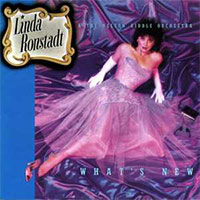 Jazz and Pop Standards
Jazz and Pop Standards
In 1981, Linda Ronstadt produced and recorded an album of jazz and pop standards (later marketed in bootleg form) titled “Keeping out of Mischief” with the assistance of producer Jerry Wexler. However, Ronstadt’s displeasure with the final result led her to regretfully scrap the project. “Doing that killed me”, she said in a Time magazine interview. But the appeal of the album’s music had seduced Ronstadt, as she told Downbeat magazine in April 1985, crediting Wexler for encouraging her. Nonetheless, Ronstadt had to somehow convince her reticent record company, Elektra Records, to greenlight this type of album under her contract.
By 1983, Ronstadt had enlisted the help of conductor and master of pop orchestration, Nelson Riddle. The two embarked on an unorthodox and original approach to rehabilitating the Great American Songbook, recording a trilogy of highly successful traditional pop albums: What’s New (1983); Lush Life (1985); and For Sentimental Reasons (1986). The three have a combined sales of over 8 million copies in the U.S.
Ronstadt faced considerable pressure not to record What’s New or record with Riddle. According to jazz historian Peter Levinson, author of the book September In The Rain – a Biography on Nelson Riddle, Joe Smith, president of Elektra Records, was terrified that the Nelson Riddle album would turn off Ronstadt’s rock audience. Linda did not completely turn her back on her rock and roll past, however; the video for the title track featured Danny Kortchmar as the old beau that she bumped into during a rainstorm.
What’s New brought Nelson Riddle to a younger audience. According to Levinson “the younger audience hated what Riddle had done with Frank Sinatra, which in 1983 was considered “Vintage Pop”. Working with Ronstadt, Riddle brought his career back into focus in the last three years of his life. Stephen Holden of the New York Times wrote, What’s New “isn’t the first album by a rock singer to pay tribute to the golden age of the pop, but is … the best and most serious attempt to rehabilitate an idea of pop that Beatlemania and the mass marketing of rock LPs for teen-agers undid in the mid-60s … In the decade prior to Beatlemania, most of the great band singers and crooners of the 40s and 50s codified a half-century of American pop standards on dozens of albums … many of them now long out-of-print”. What’s New is the first album by a rock singer to have major commercial success in rehabilitating the Great American Songbook.
In 1984, Ronstadt and Nelson Riddle performed these songs live, in concert halls around Australia, Japan and the United States, including Carnegie Hall.
In 2004, Ronstadt released Hummin to Myself, her first and ironically her only album for Verve Records. It was her first foray into traditional jazz since her sessions with Jerry Wexler and her records with the Nelson Riddle Orchestra, but this time with a smaller jazz combo. The album was a quieter affair for Ronstadt, receiving few interviews and only one television performance as promotion. The album debuted at No. 2 on the Billboard Top Jazz Albums Chart, and not having the mass distribution Warner Music gave her, Hummin’ To Myself has sold over 100,000 copies in the US which is quite successful for a small record label like Verve Records and it did achieve critical acclaim from the jazz cognoscenti.
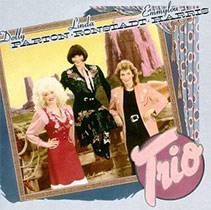 The Trio recordings
The Trio recordings
“When (we) sang, it was a beautiful and different sound I’ve never heard before. We (recorded the vocals) as individual parts, because we didn’t have the luxury of spending a lot of time together on a tour bus…and knowing each other’s (vocal) moves…takes years.”
?Linda Ronstadt
In 1978, Ronstadt, with Dolly Parton and Emmylou Harris, began recording a Trio album. The attempt was not successful. Ronstadt later remarked that not too many people were focused at the time and everyone was too involved with their own careers. (Though the efforts to complete the album were abandoned, a number of the more successful recordings were included on the singers’ respective solo recordings over the next few years.) This concept album was put on the back burner for almost ten years.
In January 1986, the three eventually did make their way into the recording studio, where they spent the next several months working. The result, Trio, which they had conceived ten years earlier, was released in March 1987. It was a considerable hit, holding the No. 1 position on Billboard’s Country Albums chart for five weeks running and hitting the Top 10 on the Pop side also. Selling over three million US copies and winning them a Grammy Award for Best Country Performance by a Duo or Group with Vocal, it produced four top-ten country singles including “To Know Him Is To Love Him” which hit No. 1. The album was also a nominee for overall Album of the Year, in the company of Michael Jackson, U2, Prince, and Whitney Houston.
In 1994, the three performers attempted to record, a follow-up to Trio with Ronstadt and George Massenburg serving as producers. As was the case with their aborted 1978 effort, conflicting schedules and competing priorities delayed the album’s release indefinitely. Ronstadt, who had already paid for studio time, and owing her record company a finished album, removed, per Parton’s request, Dolly’s individual tracks, kept Emmylou Harris’ vocals on, and produced a number of the recordings which she subsequently put on her 1995 Feels Like Home cd.
However, in 1999, Ronstadt, Parton and Harris agreed to release the Trio 2 album, as was originally recorded in 1994. Again, with Ronstadt and Massenburg producing. It included a cover of Neil Young’s “After The Gold Rush” which became a popular music video. The effort was certified Gold (over 500,000 copies sold) and won them a Grammy Award for Best Country Collaboration with Vocals for the track. Ronstadt co-produced the album with George Massenburg and both received a Grammy Nomination for Best Country Album.
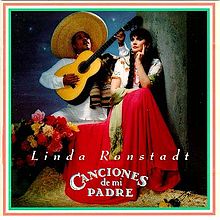 Canciones – songs of her family
Canciones – songs of her family
Linda Ronstadt, ca. 1987, on the cover of the Grammy winning album and 2x platinum certified Canciones de Mi Padre – “My Father’s Songs“.
At the end of 1987, Ronstadt released an album of traditional Mexican folk songs, or what she describes as “world class songs”, titled Canciones de Mi Padre – “My Father’s Songs”. Keeping with the Ronstadt theme, her cover art was dramatic, bold, and colorful. For Canciones De Mi Padre Ronstadt was in full Mexican regalia and her musical arranger was famed Mariachi musician Ruben Fuentes.
These canciones were a big part of Ronstadt’s family tradition and musical roots. For example, the history of this album goes back half a century. In January, 1946, the University of Arizona published a booklet by Luisa Espinel entitled Canciones de mi Padre. Luisa Espinel was Linda Ronstadt’s aunt and an international singer in the 1920s. Ms. Espinel’s father was Fred Ronstadt (Linda Ronstadt’s grandfather), and the songs she had learned, transcribed and published were some of the ones he had brought with him from Sonora. Ronstadt researched and extracted from the favorites she had learned from her father Gilbert and she called her album by the same name as her aunt’s booklet and as a tribute to her father and his family. Though not fully bilingual, she has a fairly good command of the Spanish language, allowing her to sing Latin American songs with little discernible accent; Ronstadt has often identified herself as Mexican-American. Her formative years were spent with her father’s side of the family. In fact, in 1976 Ronstadt co-wrote, along with her father, a Traditional Mexican folk ballad, titled “Lo siento mi vida”, a song that she included in her Grammy winning album – Hasten Down the Wind. Also, Ronstadt has credited Mexican singer Lola Beltran as an influence in her own singing style, and she recalls how a frequent guest to the Ronstadt home, Eduardo ?Lalo? Guerrero, father of Chicano music, would often serenade her as a child.
This album won Ronstadt a Grammy Award for Best Mexican-American Performance. The real achievement however is the disc’s RIAA double-platinum (over 2 million US copies sold) certification – making it the biggest-selling non-English language album in US music history. Another achievement is that the album and later theatrical stage show, served as a benchmark of Latin cultural renaissance in North America.
She recorded two additional discs of Latin music in the early 1990s. Although their promotion, like all her albums in the 1990s, was a quieter affair for Ronstadt, where she appeared to do the “bare minimum” to promote. They were not as successful in terms of sales as Canciones De Mi Padre, but were critically acclaimed. The first one she recorded was Mas Canciones, a follow up to the first Canciones. For this effort she won a Grammy award for Best Mexican/Mexican-American Album. The same year she stepped outside of Mariachi genre and decided to record well known “afro-Cuban” songs. This disc was titled Frenesi. Like her second Latin recording venture, this third Latin album won Ronstadt another Grammy award, this time for Best Traditional Tropical Latin Album.
In 1991, Ronstadt participated in La Pastorela, a musical filmed at San Juan Bautista. It was written and directed by Luis Valdez, of Canciones de Mi Padre fame, and like Canciones, the production was part of the PBS “Great Performances” series. It currently exists on VHS format but has not been released on DVD.
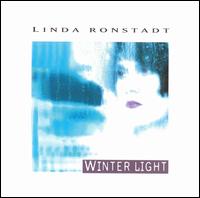 A return to roots music
A return to roots music
Continuing with her crafted approach to more mainstream-oriented material, Ronstadt released the highly acclaimed Winter Light album at the end of 1993. It includes New Age arrangements such as the lead single “Heartbeats Accelerating” as well as the self-penned title track and features the unique glass armonica instrument. It was her first commercial failure since 1972, and peaked at #92 in Billboard, whereas 1995’s Feels Like Home was Ronstadt’s much heralded return to country-rock and included her version of Tom Petty’s classic hit “The Waiting”. The single’s rollicking, fiddle-infused flip side, “Walk On”, returned Ronstadt to the Country Singles chart for the first time since 1983. An album track entitled “The Blue Train” charted 10 weeks in Billboard’s Adult Contemporary Top 40. This album fared slightly better than its predecessor, reaching #75. Both albums were later deleted from the Elektra/Asylum catalog. Ronstadt was nominated for three Lo Nuestro Awards in 1993: Female Regional Mexican Artist of the Year, Female Tropical/Salsa Artist of the Year, and her version of the song “Perfidia” was also listed for Tropical/Salsa Song of the Year.[113]
In 1996, Ronstadt produced Dedicated to the One I Love, an album of classic rock and roll songs reinvented as lullabies. The album reached #78 in Billboard and won the Grammy Award for Best Musical Album for Children.
In 1998, Ronstadt released We Ran, her first album in over two years. The album harkened back to Ronstadt’s country-rock and folk-rock heyday. She returned to her rock ‘n’ roll roots with vivid interpretations of songs by Bruce Springsteen, Doc Pomus, Bob Dylan, and John Hiatt. The recording was produced by Glyn Johns. A commercial failure, the album stands – at 60,000 copies sold at the time of its deletion in 2008 – as the poorest-selling studio album in Ronstadt’s Elektra/Asylum catalog. We Ran did not chart any singles but it was well received by critics.
Despite the lack of success of We Ran, Ronstadt kept moving towards this adult rock exploration. In the summer of 1999, she released the album Western Wall: The Tucson Sessions, a folk-rock-oriented project with EmmyLou Harris. It earned a nomination for the Grammy Award for the Best Contemporary Folk Album, and made the Top 10 of Billboard’s Country Albums chart (#73 on the main Billboard album chart). However, it would sell roughly half the number of copies that Trio II sold and had gone out of print as of December 2010.
Also in 1999, Ronstadt went back to her concert roots, when she performed with the Eagles and Jackson Browne at Staples Center’s 1999 New Year’s Eve celebration kicking off the December 31 end-of-the-millennium festivities. As Staples Center Senior Vice President and General Manager Bobby Goldwater said, “It was our goal to present a spectacular event as a sendoff to the 20th century”, and “Eagles, Jackson Browne, and Linda Ronstadt are three of the most popular acts of the century. Their performances will constitute a singular and historic night of entertainment for New Year’s Eve in Los Angeles.”[114]
In 2000, Ronstadt completed her long contractual relationship with the Elektra/Asylum label. The fulfillment of this contract commenced with the release of A Merry Little Christmas, her first holiday collection, which includes rare choral works, the somber Joni Mitchell song “River”, and a rare recorded duet with the late Rosemary Clooney on Clooney’s signature song, “White Christmas”.
Retirement
In 2011, Ronstadt was interviewed by the Arizona Daily Star and announced her retirement. In August 2013, she revealed to AARP that she has Parkinson’s disease, and “can no longer sing a note”.
More Bio Articles on Linda Ronstadt:
Linda Ronstadt Bio on Wikipedia
Linda Ronstadt Biography on Rolling Stone
This bio page is based on the copyrighted Wikipedia article Linda Ronstadt; it is used under the Creative Commons Attribution-ShareAlike 3.0 Unported License.